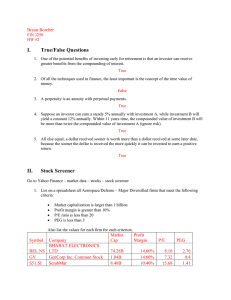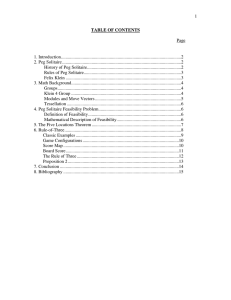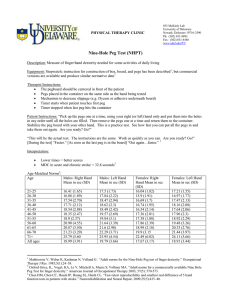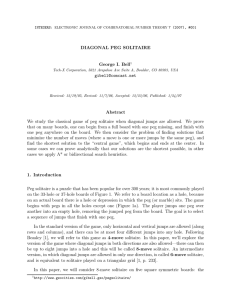Are You InKLEINed - 4 Solitaire?
advertisement
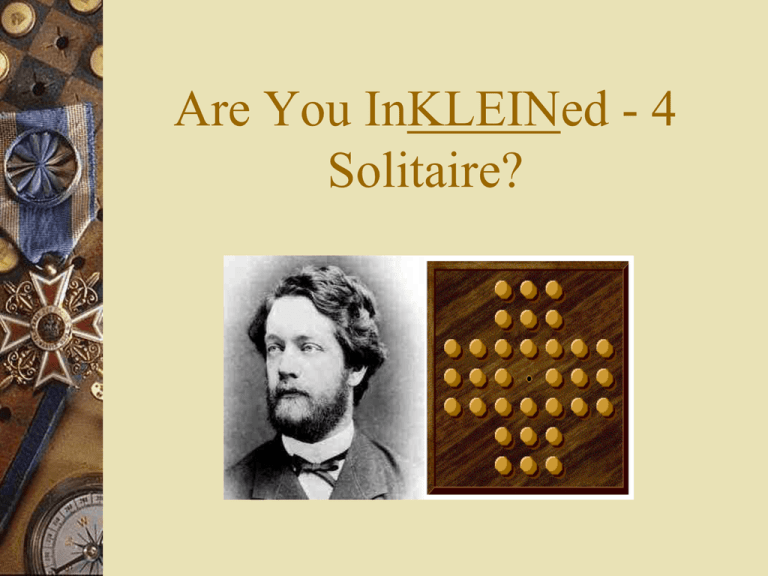
Are You InKLEINed - 4
Solitaire?
Presented by:
Matt Bach
Ryan Erickson
Angie Heimkes
Jason Gilbert
Kim Dressel
History of Peg Solitaire
Invented by French Noblemen
in the 17th Century, while
imprisoned in the Bastille
The game used the Fox &
Geese Board that was used by
many games in Northern
Europe prior to the 14th
Century
Fox and Geese Board
May have originated from
Iceland
The game is 2 player
Consists of 1 black token
and 13 white tokens
The Fox must capture as
many geese as he can so they
can’t capture him
The Geese must maneuver
themselves so they can
prevent the fox from
escaping.
Puzzle Pegs
This is a 19th Century version of Peg Solitaire
Puzzle-Peg
A 1929 version of Peg Solitaire
Jewish Version
Made at Israel in 1972 with instruction printed in Hebrew.
Very identical to the previous versions
Teasing Pegs
This game has an alternative
called French Solitaire.
Hi-Q
Felix Klein
We are modeling peg
solitaire on the Klein
4-Group named after
him.
Born in Dusseldorf
in 1849
Studied at Bonn, Got
Tingen, and Berlin
Fields of Work
Non-Euclidean geometry
Connections between geometry and group
theory
Results in function theory
More about Felix Klein
He intended on becoming a physicist, but that changed when
be became Plucker’s assistant.
After he got his doctorate in 1868, he was given the task of
finishing the late Plucker’s work on line geometry
At the age of 23, he became a professor at Erlangen, and held
a chair in the Math Department
In 1875, He was offered a chair at the Technische Hochschule
at Munich where he taught future mathematicians like Runge
and Planck.
Rules of Peg Solitaire
Rule 1: You can only move a
peg in the following
directions: North, South,
East, and West.
Rule 2: During a move, you
must jump over another peg
to the corresponding empty
hole.
Rule 3: To win, you must
only have one peg remaining
on the board
Example Game (Cross)
Initial Configuration
1st Move
Cross (1st & 2nd Move)
Cross (2nd & 3rd Move)
Cross (3rd & 4th Move)
Cross (4th & 5th Move)
You Win!!!
Other Peg Solitaire Games
Arrow
Diamond
Double Arrow
Pyramid
Fireplace
Standard
GROUPS
Let G be a nonempty set with operation *
a, b, c are elements of G
e is the identity element of G
G is a GROUP if it has:
1.
2.
3.
4.
Binary Operation
Associative
Identity
Inverses
a*b G for all a, b G
(a*b)*c = a*(b*c) for all a, b, c G
a*e = e*a =a for all a G
a*b = b*a = e
SPECIAL PROPERTIES
If the group has the property :
a*b = b*a
then the group is called ABELIAN
A group is called CYCLIC if an element aG
such that
G = { a n nZ}
KLEIN 4 GROUP
It has two special properties
1. Every element is its own
inverse
2. The sum of two distinct
non zero elements is
equal
to the third element
The Klein 4 Group is the
direct sum of two cyclic
groups.
Z Modules
An integer module is similar to a vector space.
B
Z
In our case,
contains:
Configuration Vectors
Move Vectors
and contains values described by lattice points
B
Z
{-1,
0,
1,
2, -3}
(0,0) (1,0) (0,1) (–1,0) (0,-1)
Move Vectors
Equations are represented in the following way:
e ij is a configuration with a peg in the (i,j)th position.
Moves are made by adding and subracting these vectors.
r i , j e i 1, j e i , j e i 1, j
l i , j e i 1, j e i , j e i 1, j
d i , j e i , j 1 e i , j e i , j 1
u i , j e i , j 1 e i , j e i , j 1
Module Homomorphism
Properties
The mapping must satisfy these
properties:
1. (a + b) = (a) + (b)
2. (ca) = c(a)
A KERNEL of a homomorphism from
a group G to another group is the set:
{xG| (x) = e}
The kernel of is denoted as Ker
TESSELLATION
A mapping of the Klein 4 Group onto the
board
Definition of Feasibility
The dictionary defines feasibility as follows:
Can be done easily; possible without
difficulty or damage; likely or probable.
Peg Solitaire Feasibility
Problem
Objective:
1. We want to prove whether a certain
board configuration is possible.
2. We must prove there is a legal sequence
that transforms one configuration into
another.
3. Use the 5 Locations Thm and the Rule of
Three to solve the feasibility problem.
How the Feasibility Problem
Works
Given a Board B and a pair of
configurations (c,c') on B, determine if the
pair (c,c') is feasible.
The Solitaire Board
The Solitaire Board is defined as follows:
B Z ZxZ
2
The board is a set of integer points in a plane
C and C' are tessellations or configuration vectors
of the board
C' is “1 – C” or the opposite of C
The Five Locations Theorem
Dr. Arie Bialostocki
Prove: If a single peg
configuration is
achieved, the peg
must exist in one of
five locations
Prerequisites
English style game
board
Game begins with one
peg removed from the
center of the board
General rules apply
Game Ending Configuration
Five locations in
which a single peg
board configuration
can be achieved
Klein 4 Group
Additive Cyclic Group
I. Every element is it’s
own inverse
II. The sum of any two
distinct nonzero
elements is equal to
the third nonzero
element
Board Tessellation
Assign x, y, z values
to a 7x7 board starting
in row 1 and column 1
Map from left to right,
top to bottom
Remove the four
locations from each of
the four corners to
produce a board
tessellation
Adding Using Tessellation
By Klein 4 properties
I and II, the sum of
any x + y + z = 0
Therefore, adding up
the individual pegged
locations based on the
tessellation, the total
board value initially
= y
Calculating After Move
For any move, the
sum of two elements
from x, y, z is
replaced by the third
element
According to property
II of Klein 4 groups,
this substitution does
not affect the overall
sum of the board
Peg Must Be Left In Y
Therefore, a single
peg can only be left in
a y location
However, because of
the rules of symmetry,
six of these eleven
locations must be
removed
Five Locations Remain
Therefore, only five
locations remain and
Dr. Bialostocki’s Five
Locations Theorem
holds.
Notion for Scoring
:
Let
2
2
2
{a, b, c, e}
is the Klein 4 - Group
2
2
is the Klein Product Module
Abelian group with the following properties
a+a=b+= c+c=e
a + b = c, a + c = b , b + c = a
Classic Examples
Define two maps g1, g 2 : 2
2
2
Define two maps
g
1
g
2
How did they get that?
g
1
(i, j ) : a if (i j ) 0 (mod 3)
b if (i j ) 1 (mod 3)
c if (i j ) 2 (mod 3)
g
2
(i, j ) : a if (i j ) 0 (mod 3)
b if (i j ) 1 (mod 3)
c if (i j ) 2 (mod 3)
Game Configurations
A single peg or “basis vector” is represented by
the following:
e
ij
(0,0,......0,1,.....0)
filled
empty
Score Map
(A module homomorphism- a linear like
map)
For any board B , the score map can be
defined by the following notation:
2
:
B
2
2
As shown by the previous examples
(
e
ij
) ( g (i, j),
1
c
Thus the score of
(c )
g (i, j))
2
B
c ( g (i, j), g (i, j))
ij
( i , j )B
1
2
An Example
e
0,0
= board vector that has a peg in (0,0) and
is empty every where else.
(e0,0) = 1* ( g1 (0,0)
= 1 * (a , a)
= (a , a)
, (
g (0,0))
2
The Board Score
B = English 33- board
C = 0,0
e
(B)= ( e0,0 ) + (1 - e0,0 )
= (a , a) + (a , a)
=(a + a, a + a)
=(e , e)
g
1
Note:
Let mij
We can show that (mij) ( e, e)
For example,
r ij ei1, j eij
B
e
i 1, j
(r 0,0) (e1,0) (e0,0) (e1,0)
(r 0,0) (b, b) (a, a) (c, c)
( r 0 , 0 ) (c, c ) ( c, c )
(r 0,0) (e, e)
Rule of Three
A necessary condition for a pair of
configuration (c, c) to be feasible is that
(c - c) = (e, e), namely, c - c er().
Proof:
Suppose (c,c ) is feasible.
k
Then c = c +
k
m
m
i 1
i
i
(c) = [c +
m
i 1
k
i
m
i
i 1
]
(c) = (c) + ( mi )
(c)= (c) + (e,e)
(c)= (c) + (e,e)
(c) - (c) = (e,e)
(c - c) = (e,e)
Proposition 2
Let B be any board. A necessary condition
c ) to be
for the configurations
pair
(c,
feasible, with c = 1 - c the complement
of c, is that the board score is (B) = (e,e).
Proof:
Assume(c, c ) is feasible. c = 1 - c
By the Rule of Three c - c Ker(), i.e.
( c - c ) = (e,e)
( c) - ( c) = (e,e)
( c) = (e,e) + ( c)
( c) = (c)
Proof Continued:
However:
(B) = ( c) + (c )
(B) = ( c) + ( c)
(B) = (e,e)
Conclusion
By using the Five Locations Theorem, and
the Rule of Three, we have shown how it is
possible to come up with the winning
combinations in peg solitaire, and have
shown why they work
Possible Questions
Can this model be applied to other games?
How many solutions are there to the Peg
Solitaire Game?
Is there a general algorithm for solving
central solitaire?
References
Dr. Steve Deckelman
“An Application of Elementary Group Theory
to Central Solitaire”
– by Arie Bialostocki
“Solitaire Lattices”
– by Antoine Deza, Shmuel Onn
Websites
– http://bio.bio.rpi.edu/MS99/WhitneyW/advance/klein.ktm
– http://library.thinkquest.org/22584/temh3043.htm
– http://physics.rug.ac.be/fysica/Geschiedenis/mathematicians/Klei
nF.html
– http://www.ahs.uwaterloo.ca/~museum/vexhibit/puzzles/solitaire/
solitaire.html





